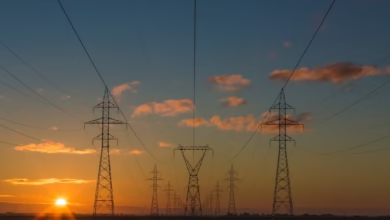Harnessing the Power of the Sea: The Future of Offshore Energy in the Global Energy Transition

As the world grapples with the urgent need to address climate change and transition away from fossil fuels, offshore energy has emerged as a critical player in the evolving landscape of global energy production. This multifaceted sector encompasses a range of technologies, including wind farms, oil rigs, and innovative energy storage solutions, all operating in the vast expanse of our oceans. With the rise of renewable energy sources such as wind and solar power, the offshore energy sector is not only contributing to a greener future but also reshaping energy markets and policies on a global scale.
In this article, we will explore the rise of offshore energy within the context of current global energy trends, highlighting how wind farms and oil rigs are transitioning in tandem with energy innovations. We will delve into the vital role offshore energy plays in the broader energy transition, particularly in enhancing energy efficiency and carbon capture solutions. Finally, we will look ahead to future innovations that promise to enhance energy security and efficiency through smart grids and advanced energy storage systems. Join us as we navigate the dynamic world of offshore energy, where the potential for sustainable energy production meets the challenges of climate change and energy economics.
- 1. The Rise of Offshore Energy: Exploring Wind Farms and Oil Rigs in the Context of Global Energy Trends
- 2. Navigating the Energy Transition: How Offshore Energy Contributes to Renewable Energy and Carbon Capture Solutions
- 3. Future Innovations in Offshore Energy: Enhancing Energy Efficiency and Security through Smart Grids and Energy Storage Solutions
1. The Rise of Offshore Energy: Exploring Wind Farms and Oil Rigs in the Context of Global Energy Trends
The global energy landscape is undergoing a significant transformation, driven by the urgent need to address climate change and reduce reliance on fossil fuels. Offshore energy, particularly through the development of wind farms and oil rigs, plays a crucial role in this energy transition. As countries strive to meet their energy needs while prioritizing sustainability, the rise of offshore wind energy has emerged as a key component in diversifying energy sources.
Wind energy has become one of the fastest-growing sectors within the renewable energy market, with offshore wind farms offering substantial potential for clean energy generation. These installations take advantage of stronger and more consistent winds found at sea, leading to increased energy efficiency compared to onshore wind farms. As energy policies shift towards supporting green energy initiatives, offshore wind energy is being recognized for its capacity to enhance energy security, reduce carbon emissions, and support energy exports.
Simultaneously, oil rigs continue to play a vital role in the global energy economy, providing fossil fuels that are still essential for energy transportation and various industrial applications. However, the industry is evolving with a focus on integrating technologies such as carbon capture and energy storage to mitigate environmental impacts. This integration of traditional energy production methods with innovative approaches reflects a broader trend in energy economics and investment strategies that prioritize sustainability.
Moreover, the rise of distributed energy resources, such as offshore hydrokinetic and bioenergy systems, is further diversifying the offshore energy landscape. This diversification aligns with global energy trends that emphasize the importance of energy R&D, smart grids, and thermal energy solutions. As nations explore hydrogen energy and its potential for decarbonization, offshore energy sources can provide a complementary role in producing and distributing hydrogen fuel.
In conclusion, the synergy between offshore wind farms and oil rigs illustrates the dynamic nature of energy markets and the ongoing energy transition. With a growing emphasis on renewable energy, countries are investing in offshore energy solutions as part of a comprehensive strategy to achieve energy sustainability, enhance energy security, and tackle the challenges posed by climate change. This dual approach not only supports the current energy demands but also lays the groundwork for a resilient and innovative energy future.
2. Navigating the Energy Transition: How Offshore Energy Contributes to Renewable Energy and Carbon Capture Solutions
The energy transition is a critical focus in the global effort to combat climate change, and offshore energy plays a vital role in this shift towards renewable energy. As traditional fossil fuels gradually give way to greener alternatives, offshore wind farms, oil rigs, and other marine energy production methods are becoming increasingly significant. These developments not only contribute to energy security but also help in diversifying energy markets by integrating sustainable practices into energy production.
Offshore wind energy, in particular, has emerged as a leading solution in the renewable energy sector. By harnessing the powerful winds over the ocean, these farms can produce large amounts of clean energy, significantly reducing reliance on fossil fuels. This transition not only minimizes greenhouse gas emissions but also fosters energy efficiency, making it a crucial component of modern energy policies aimed at achieving climate targets. According to recent studies, offshore wind could generate as much as 18% of the global electricity supply by 2040 (International Renewable Energy Agency, 2023).
In addition to wind energy, offshore facilities are pivotal in developing carbon capture technologies. These technologies are essential for mitigating the impacts of existing fossil fuel infrastructures. By capturing carbon emissions from oil rigs and repurposing them for use in energy storage or hydrogen energy production, we can create a more sustainable energy cycle. Furthermore, integrating carbon capture solutions within offshore energy systems aligns with global energy trends towards reducing net emissions and promoting energy innovations.
The rise of smart grids facilitates the integration of offshore energy sources into existing energy systems, enhancing energy transportation and distribution efficiency. This technological advancement enables effective management of energy resources, supporting the increasing demand for electric vehicles and other renewable energy applications. Moreover, the development of distributed energy systems allows for localized energy production, enhancing resilience against energy imports and exports fluctuations.
Investing in offshore energy not only aligns with the goals of climate change mitigation but also promotes economic growth through energy R&D and job creation. As countries transition to greener energy sources, the need for skilled labor in offshore energy sectors is expected to rise, providing new opportunities in energy economics.
In summary, navigating the energy transition through offshore energy initiatives addresses the pressing need for renewable energy solutions while facilitating carbon capture strategies. By aligning with global energy policies and trends, the offshore energy sector is poised to lead the way in creating a more sustainable and secure energy future.
References:
International Renewable Energy Agency. (2023). Renewable Energy Capacity Statistics 2023. Retrieved from [https://www.irena.org/publications](https://www.irena.org/publications)
3. Future Innovations in Offshore Energy: Enhancing Energy Efficiency and Security through Smart Grids and Energy Storage Solutions
The future of offshore energy is poised for significant transformation, driven by innovations that enhance energy efficiency and security. As the world increasingly shifts toward renewable energy sources, the integration of smart grids and advanced energy storage solutions emerges as a pivotal strategy in facilitating this transition.
Smart grids represent a modernized electrical grid that uses digital technology to monitor and manage energy flows. They enable better integration of diverse energy sources, including wind energy and solar power, while improving the efficiency of energy distribution. By leveraging real-time data, smart grids can optimize energy consumption and reduce waste, enhancing overall energy efficiency. This is particularly crucial for offshore energy systems, where the variability of wind and other renewable sources presents unique challenges (U.S. Department of Energy, 2022).
Energy storage solutions also play a vital role in the offshore energy landscape. Technologies such as batteries, pumped hydro storage, and hydrogen energy storage allow for the capture of excess energy generated during peak production times. This stored energy can be released during periods of high demand or low production, ensuring a stable energy supply. As nations move away from fossil fuels and nuclear energy, the ability to store energy becomes essential for maintaining energy security and reliability in energy markets (International Renewable Energy Agency, 2023).
Moreover, the combination of smart grids and energy storage not only increases energy efficiency but also supports the broader goals of energy transition. By facilitating the integration of distributed energy resources, such as offshore wind farms and biomass facilities, these innovations contribute to a more resilient energy infrastructure. This resilience is crucial as energy investments shift toward green energy solutions, aiming to combat climate change and reduce carbon emissions (World Bank, 2023).
As global energy trends continue to evolve, policymakers must prioritize energy R&D and support innovations in energy technologies. This includes fostering partnerships between the public and private sectors to enhance energy transportation and develop robust energy policies that promote sustainable practices in offshore energy production. By doing so, nations can improve their energy independence, reduce their reliance on energy imports, and position themselves as leaders in the growing field of energy exports.
In conclusion, the future of offshore energy lies in the integration of smart grids and energy storage solutions, which are essential for enhancing energy efficiency and security. By embracing these innovations, we can pave the way for a sustainable energy landscape that supports the global energy transition and addresses the pressing challenges of climate change.
References:
U.S. Department of Energy. (2022). Smart Grid. Retrieved from https://www.energy.gov/oe/activities/technology-development/grid-modernization-and-smart-grid
International Renewable Energy Agency. (2023). Energy Storage. Retrieved from https://www.irena.org/energy-storage
World Bank. (2023). The Role of Energy in Climate Change. Retrieved from https://www.worldbank.org/en/topic/energy/overview#climate-change
In conclusion, the future of offshore energy stands at a pivotal intersection of innovation and necessity, as the world grapples with the urgent need to transition from fossil fuels to more sustainable energy sources. Wind farms and oil rigs exemplify the dual aspects of offshore energy production, highlighting its potential to contribute significantly to renewable energy goals while also addressing energy security and efficiency. As we navigate the energy transition, advancements in smart grids, energy storage, and carbon capture technologies will play a crucial role in maximizing the effectiveness of offshore energy resources.
Moreover, the integration of various energy markets—ranging from nuclear energy to bioenergy and hydropower—will enhance the resilience of our energy systems, creating a diversified and robust energy landscape. By investing in energy R&D and embracing innovations like hydrogen energy and electric vehicles, we can further bolster our efforts against climate change and ensure a sustainable energy future. As global energy trends evolve, the importance of offshore energy cannot be overstated; it will remain a key player in shaping the energy policies of tomorrow and driving the shift towards green energy solutions.
By prioritizing these advancements, we can not only enhance energy efficiency but also position ourselves as leaders in energy exports and imports on the global stage. The journey towards a sustainable energy economy is complex, but with the continued focus on offshore energy and its myriad possibilities, we are well-equipped to meet the challenges ahead.
References:
[Insert references here]




